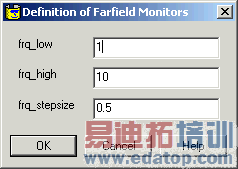- 易迪拓培训,专注于微波、射频、天线设计工程师的培养
CST2013: Mesh Properties (Tetrahedral)
 Simulation: Mesh
Simulation: Mesh  Global Properties
Global Properties
Note: The active mesh type refer merely to the mesh preview. A change of the solver method will change the active mesh type.
Mesh density control frame
Steps per wavelength: This value is connected to the wavelength of the highest frequency set for the simulation. It defines the minimum number of mesh cells that are used for a distance equal to this wavelength.
This sets the spatial sampling rate for the signals inside of your structure. This setting has a strong influence on the quality of the results and on the calculation time. Increasing this number leads to a higher accuracy, but unfortunately also increases the total calculation time.
A good compromise between calculation time and the achievable accuracy is the default value of 4 for tetrahedral meshing.
Minimum number of steps: This value controls the global relative mesh size and defines a lower bound for the number of mesh cells independently of the wavelength. It specifies the minimum number of mesh edges to be used for the diagonal of the model bounding box. Consequently, the higher this value the finer the mesh.
Together with the possibility to set local mesh sizes, see Local Mesh Property (Tetrahedral), this is the most important quantity to control the automatic tetrahedral mesh generator. Please mind that tetrahedral meshes combined with first order elements need a higher resolution to gain the same accuracy as when higher order elements are used.
Material based refinement
With this option the material-based refinement can be switched on or off.
Mesh summary frame
The values shown in this frame are only for information purposes. You can not edit them.
Min. edge length: The length of the shortest mesh edge.
Max. edge length: The length of the longest mesh edge.
Tetrahedrons: The number of mesh cells.
Min. quality: The minimum of all mesh cell quality values.
Max. quality: The maximum of all mesh cell quality values.
Average quality: The average of all mesh cell quality values.
Note:
The quality of a tetrahedron measures how good its shape matches the shape of an ideal, equilateral tetrahedron. It is defined by the expression
 ,
,
where rin is the inradius of the tetrahedron and rcirc the circumradius. The factor 3 is a scaling factor, such that the quality is positive and less or equal to one. Low quality values indicate degenerated mesh cells, which may have a negative impact on the convergence.
OK
Accepts the changes and closes the dialog. If changes were made, the mesh will be updated.
Apply
Stores the current settings. The dialog box open remains open.
Cancel
Closes this dialog box without performing any further action.
Update
Updates the mesh representation.
Specials...
Leads to a special dialog box that allows you control the automatic mesh generator.
Simplify model...
Use this button to globally reduce the complexity of your model.
Help
Shows this help text.
CST微波工作室培训课程套装,专家讲解,视频教学,帮助您快速学习掌握CST设计应用
上一篇:CST2013: View Options - General
下一篇:CST2013: View Options - Illumination
 最全面、最专业的CST微波工作室视频培训课程,可以帮助您从零开始,全面系统学习CST的设计应用【More..】
最全面、最专业的CST微波工作室视频培训课程,可以帮助您从零开始,全面系统学习CST的设计应用【More..】
频道总排行
- CST2013: Mesh Problem Handling
- CST2013: Field Source Overview
- CST2013: Discrete Port Overview
- CST2013: Sources and Boundary C
- CST2013: Multipin Port Overview
- CST2013: Farfield Overview
- CST2013: Waveguide Port
- CST2013: Frequency Domain Solver
- CST2013: Import ODB++ Files
- CST2013: Settings for Floquet B
